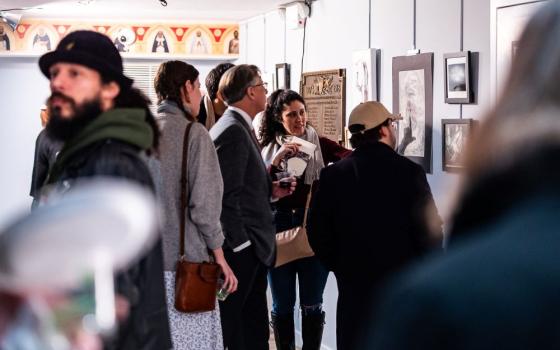Try as we might to remind ourselves that the Catholic church isn't Microsoft and that quantitative measures of success or failure don't always correspond to the logic of the Gospel, most of us take that lesson to heart only selectively. Some Catholics can't resist touting the huge crowds at World Youth Day as an endorsement of their version of orthodoxy; others cite polling majorities in favor of reform on birth control and other issues as proof of the sensus fidelium.
The most powerful recent instance of that temptation has been Catholic reaction to the 2008 "Religious Landscape Survey" from the Pew Forum, which documented a remarkable fluidity in religious affiliation in America -- almost half of American adults have either switched religions or dropped their ties to religion altogether.
For Catholicism, the banner headline was that there are now 22 million ex-Catholics in America, by far the greatest net loss for any religious body. One in three Americans raised Catholic have left the church. Were it not for immigration, Catholicism in America would be contracting dramatically: for every one member the church adds, it loses four. On the other hand, the study also found that the Catholic church has a higher retention rate than other major Christian denominations, and that 2.6 percent of the adult population is composed of converts to Catholicism, representing a pool of nearly six million new Catholics.
Naturally, critics of various aspects of Catholic life, such as the sexual abuse crisis or what some see as an overly conservative ideological drift, see the defections as proof of malaise. (A prominent American theologian recently claimed the Pew data reveal a "mass exodus" from the church, which he linked to a preoccupation by some bishops with the culture wars.) Equally predictably, Catholics content with the status quo play up the good news.
Given the disparities in interpretation, I turned to the director of the Pew Forum, Luis Lugo, to try to understand what the data really have to say. I spoke to Lugo by phone Thursday morning, and we were joined by Pew senior researcher Greg Smith.
Here's the bottom line: In comparison with other religious groups in America, the Catholic church's struggles aren't really with pastoral care, but missionary muscle. Overall, Catholicism serves existing members fairly well, as measured by the share that chooses to stick around; what it doesn't do nearly as well is to evangelize. The data do not reflect widespread dissatisfaction in the pews, at least to any greater extent than other religious bodies face. Instead, they reveal a problem with getting people into the pews in the first place.
To put all that into crass capitalistic terms, in America's highly competitive religious marketplace, the real Catholic problem isn't customer service but new sales.
Even if one were to focus just on defections, it's not clear which ideological camp in today's church could claim vindication. While many former Catholics object to church teachings on issues such as abortion and homosexuality, one in ten Protestant Evangelicals in America today is also an ex-Catholic, many of whom deserted Catholicism because it wasn't conservative enough. Finally, there's a clear plug for youth ministry implied in the Pew data: Roughly two-thirds of those who abandon Catholicism do so before they're 23, which means the make-or-break period is adolescence and early adulthood.
The following are excerpts from our conversation.
* * *
What reactions do you get when you discuss these findings with Catholics?
Lugo: People are often a little befuddled when I present the full range of evidence, which puts a different light on things. From headlines, they may have the impression that the Catholic church is just bleeding members, but that's out of context. You have to compare it to retention rates of other religious groups, and see it in terms of retention plus recruitment. It's the net relationship between those two factors that's so crucial.
Everybody's losing members in this country, some even more than Catholics. In percentage terms, Catholic losses are not out of line with other groups. It's on the recruitment side that Catholics are not doing as well. Protestants are losing lots of members too, but for every four Americans who are no longer Protestant, there are three who are Protestant today who were not raised that way. Protestantism is declining as a whole, but the recruitment rate is pretty good. Catholics are not replenishing their ranks through conversion in the same way.
There are two other key variables. One is immigration, and the other is higher-than-average fertility rates among Hispanic Catholics. If the only factor driving a religious group's share of the population were conversion, the Catholic church would be declining.
Smith: One of the things I was struck by, especially with regard to the Catholic church, is the degree to which apparent stability masks enormous change just below the surface. If all you look at is the percentage of the population who told us they're Catholic, it's exactly what we've found for four decades, and you would think nothing much is going on. Nothing could be further from the truth.
In his recent Murray/Bacik Lecture at the University of Toledo, noted Catholic theologian Richard Gaillardetz said the Pew data confirm a "mass exodus from the church." Is it accurate to talk about a "mass exodus"?
Lugo: In the context of American religion as a whole, it's not really accurate. In fact, Catholic losses are right in line with what we see overall in terms of people changing affiliation in this country. Look at the fastest-growing religious group in America, the unaffiliated. Even there, half of all people who were raised without an affiliation have since joined a religion! Or take the group that everybody considers to be the most dynamic, the Jehovah's Witnesses. Those results blew me out of my chair. Two-thirds of those raised as Jehovah's Witnesses say they're no longer members, which is double the losses of the Catholic church in percentage terms.
What really strikes me about the Catholic numbers is on the recruitment side. The Jehovah's Witnesses grow because they recruit even more than they lose, which is not the case for the Catholics.
Smith: It's not fair to say there's a "mass exodus" from Catholicism more than any other faith. You have to bear two things in mind. First, because so many people were raised Catholic, it means that in terms of raw numbers, there are a lot of former Catholics out there. It's not because Catholics do a worse job keeping their members, but because so many were raised Catholic. Second, if all you looked at is retention, you would probably say that Catholics are doing just as well as other groups, and even better than many of them. But one of the points of the report is that to understand the dynamics of American religion, you have to see retention and recruitment together. It's the churn, the ratio of leaving to joining, which matters. It's the recruitment side that sets Catholics apart. Four people leave Catholicism for every one who joins, and there's no other religious group where you see a similar ratio. Baptists, for example, also have more people leaving than joining, but their ratio of 2-1 is twice of what we see for Catholics.
Is the take-away not that Catholics have a problem serving existing members, but that Catholics need to ramp up their missionary efforts?
Lugo: In terms of sheer numbers, that's right. I wouldn't want to say that the church shouldn't be thinking about pastoral strategies to retain its current members, especially young people. The retention side can't be overlooked, and there are important pastoral implications there. Yet the bottom line is that if you're a religious group in this country, you're going to lose members in significant numbers. Half of all Americans say they've changed affiliation at least once, so churn is the name of the game. Even if the Catholic church did a markedly better job of retention, if it can't make up a significant share of its membership through recruitment, its ratio will not be very impressive.
I know that all the RCIA people will probably be mad, because they're already over-burdened, but your question nails it: The most striking thing about Catholicism in America isn't that it's losing people, but that it's not recruiting them as successfully as other groups. I should add that when I'm presenting this data, I always say that the 2.6 percent of American adults who are converts to Catholicism is a huge pool of folks, so it's not like nothing is going on.
What do we know about why those 22 million ex-Catholics left the church?
Lugo: It's very interesting, because we have to break it down between those who have joined the ranks of the unaffiliated and those who have become Protestants. When you do that, it's by no means clear, from a purely retention point of view, whether the church ought to become more liberal or more conservative! Bear in mind that among those becoming Protestants, a majority are Evangelicals. One out of ten Evangelicals in America today is a former Catholic, and many of those folks say the Catholic church isn't conservative enough.
Smith: It's impossible to say in broad strokes why people leave, because it depends on where they're headed. Among former Catholics who are now unaffiliated, 65 percent say they just stopped believing the religion's teachings. A majority also cites unhappiness with specific teachings; 58 percent say they were unhappy with the teaching on things like abortion and homosexuality, and 48 percent or so were unhappy with the teaching on birth control. However, even more say they just gradually drifted away. 71 percent of former Catholics who are now unaffiliated say that.
Lugo: For that group, one gets the sense of gradually, almost imperceptibly, stepping away from the church. Many were already fairly "secularized" before they stopped identifying as Catholics. It's less for highly principled theological reasons, that they just can't take this church anymore, and more for the drift factor.
Smith: For those who have become Protestants, 71 percent say their spiritual needs weren't being met in the Catholic church. The same number, however, say happiness with their new religion was more important than dissatisfaction with the old one. What's interesting is differences between those former Catholics who have become Evangelicals, and those who have joined one of the mainline Protestant churches. More than half of those who are now Evangelical cite Catholic teaching about the Bible as a factor in their decision, and most say that the Catholic church does not view the Bible literally enough. Only 16 percent of former Catholics now in mainline Protestantism cite the Bible, and those who do are about evenly divided between those who say Catholicism takes the Bible too literally and those who say it's not literal enough.
Lugo: We also find that where ex-Catholic Evangelicals tend to cite reasons of belief and theology, those in mainline Protestant churches tend to be influenced more by what we might call "life cycle" factors, such as marrying someone of a different faith, or they didn't like the priest at their parish, and so on.
For those who leave the church, when do they do so?
Smith: In 2008 we did a follow-up survey, and we found that switching is something that usually happens early in life. Most who left Catholicism did so prior to reaching the age of 24. For those Catholics who are now unaffiliated with any religion, half left Catholicism before they turned 18, and another three in ten left during the college years, between ages 18 and 23. Among Catholics who are now Protestants, half left before 18 and another third left between 18 and 23. This is something that happens early in the life cycle.
Catholic membership is being replenished largely through Hispanic immigration. Are those Hispanics likely to remain Catholic?
Smith: People often assume that fewer Latinos leave Catholicism as compared to non-Latinos. There's something to that, although the difference is not as large as you might expect. Among non-Hispanics who were raised Catholic, 66 percent are still Catholic. Among Hispanics raised Catholic, it's 73 percent. That's a statistically significant difference, but we're not talking about night and day. Among those who have left, it's just like the non-Hispanic Catholics -- roughly half are now unaffiliated and half have become Protestants, mostly Evangelicals.
Lugo: We know there's a generational difference. The conversion rates are lower among first-generation Hispanic immigrants than in the second generation. However, the percentage in the third generation is identical to the second, so there doesn't seem to be an escalating defection rate generationally.
Latino Catholics also have by far the highest fertility rate of any ethnic religious group in the country. Among American Catholics under 40, half are now Latinos. Even if immigration rates were to ebb, therefore, it's "baked in" demographically that the Latino share of the adult Catholic population will increase.



